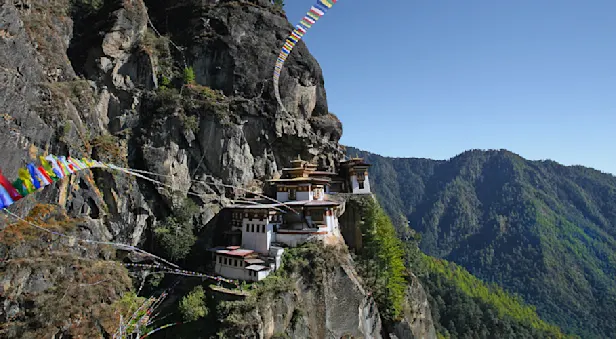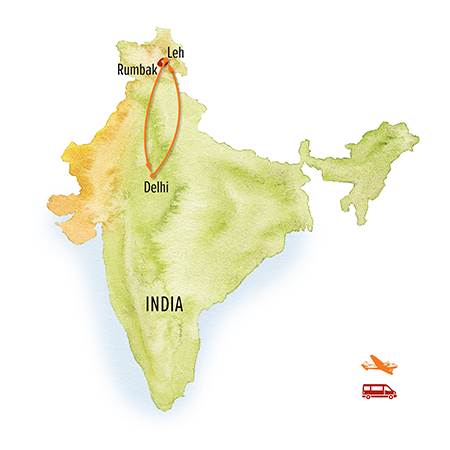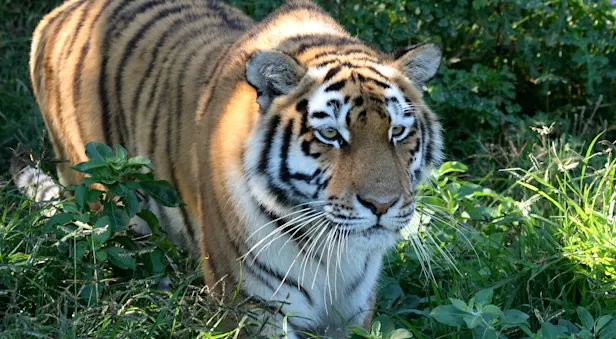Itinerary
Arrive at the international airport in India’s capital of Delhi and transfer to our luxury hotel in the high-tech suburb of Gurgaon outside the city center. This elegant contemporary low-rise hotel is surrounded by seven acres of gardens, courtyards and reflecting pools, lending a resort-like ambience. This evening, join our Expedition Leader for a welcome dinner and preview of our journey into the Indian Himalaya and the realm of Panthera uncia, the snow leopard.
Day 2: Delhi / Leh, Ladakh
Early this morning, we fly north to the former Himalayan kingdom of Ladakh. This is one of India’s least-populated regions, known for dramatic peaks, monasteries filled with golden Buddhas, and the elusive snow leopards that prowl the snowfields of an otherwise rocky, arid mountainscape. Once we touch down at 11,500 feet in the capital city of Leh, our high-altitude acclimatization begins. For centuries, Leh was a crossroads for Indus Valley trade between Tibet, Kashmir, India and China—routes that carried salt, cashmere wool, indigo and silk. The local people are ethnic Tibetans who speak Ladakhi, and Buddhism and Islam have co-existed peacefully here since the 8th century. Our lodging in the heart of this ancient city sits in the shadow of an unoccupied 17th-century palace designed to evoke the Dalai Lama’s former residence in Lhasa—the famous Potala Palace. The rest of the day is at leisure as we settle in and adjust to the high elevation.
Day 3: Leh—Exploring the Indian Himalaya
Today we travel into Leh's rural surroundings, exploring the rugged Indus River Valley. It's easy to see why this enclave at the northern tip of India is often called “Little Tibet,” as we cross passes marked with colorful prayer flags beneath towering Himalayan peaks. We stop in Gya, the oldest village in Ladakh, perched on a gorge overlooking the river. A contingent of villagers greets us with a traditional welcome before leading us on a guided tour of their town. We learn about animal husbandry, handicrafts and textiles, along with traditional barley roasting and cooking. Archery is an important element of traditional Ladakhi life, and we stop at a range where we can witness archers in their element—and to try our own hand with a bow and arrow! After a traditional lunch in a local home, set out on foot with our guide to explore the landscape, where the likelihood is high of seeing blue sheep and birdlife. Return to Leh by late afternoon, with time to rest for a bit as we continue to acclimate.
Days 4–8: Rumbak—Snow Leopard Tracking from Our Private Expedition Lodge
Following the Indus River westward, we venture deep into the snow leopard's realm. The Rumbak region is the gateway to an expansive landscape ruled by the “gray ghost of the mountains”—a name bequeathed upon the snow leopard for its solitary and elusive nature. As we drive the scenic road toward our snow leopard expedition base, be on the lookout for ibex, noted for their magnificent horns, standing vigil over rocky outcrops and couloirs.
Our private lodge was recently constructed using traditional Ladakhi techniques and materials, including stone, mud and timber, all chosen for their natural insulating properties. The most luxurious lodge in the region, it features radiant floor heating, abundant running hot water and double-glazed windows for an intimate and warm experience.
Over the next five days, we search the alpine heights in and around Hemis National Park, which holds the highest density of snow leopards in any protected area in the world—about 200. These trans-Himalayan cats have evolved to thrive in some of Earth’s harshest alpine terrain, mostly above tree line and up to 18,000 feet in elevation. Our base for exploration is a private ecolodge set on a plateau with unimpeded views of the snowcapped mountains and Rumbak River below. The nearby village of Rumbak, population 250, is a short walk away. The surrounding landscape provides habitat for three large ungulates—ibex, bharal (blue sheep) and urial (mountain sheep)—along with fox, hare, pika and packs of Tibetan wolves.
For our best chance to see snow leopards, we rely on the expertise and keen eyes of a team of local spotters, plus our naturalist Expedition Leader. These seasoned trackers scour the landscape early each morning to help us plan our route for the day and increase our luck of seeing these cats whose camouflage enables them to blend in seamlessly with their habitat. We also retain radio contact with trackers throughout the day, so we know when snow leopards wander into our area. Private vehicles maximize our flexibility to move to where the snow leopards are. Typically, we spot them on high ridges around our lodge or within a short walk from the vehicles, but longer hikes are available for those who desire.
In between excursions, the lodge offers a cozy respite for warming up with hot chai. Nearby are intriguing Ladakhi cultural sites like Buddhist temples and monasteries that we visit if time allows.
Day 9: Rumbak / Leh
After breakfast, enjoy a final morning in Rumbak, relishing our last chance to soak in the wild peace of this alpine domain. Later, say farewell to our gracious Ladakhi hosts whose lodge is helping to enhance protection for snow leopards in the area. These majestic cats face threats from habitat loss due to climate change, reduced prey, poaching and human conflict, and we leave knowing that our presence here makes a difference for their future, with the value of our economic contribution and our advocacy. Back in Leh, we attend a private culinary immersion at a local Ladakhi kitchen. Later this evening, share reflections over a farewell dinner.
Day 10: Leh / Delhi / Depart
Fly from Leh to Delhi this morning and continue to our hotel where an overnight room is reserved. A delicious lunch awaits at the hotel, followed by time to relax among landscaped gardens and pools. A transfer to the international airport is included to meet departing flights this evening.
Physical Rating: Difficult
Interested in extending your trip? Link it up with another adventure!

Wild & Ancient Himalaya: Nepal & Bhutan
Explore mountain heights and jungle lowlands on this soulful journey through the cultural and wildlife treasures of two neighboring Himalayan nations—including rhino tracking in Chitwan National Park.




























